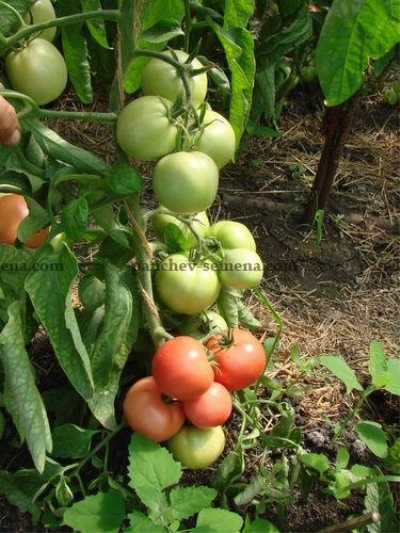
- Authors: Panchev Yu.I.
- Year of approval: 2010
- Category: hybrid
- Growth type: determinant
- Appointment: universal
- Ripening period: early
- Ripening time, days: 90-95
- Growing conditions: for open ground, for film greenhouses
- Marketability: high
- Transportability: high
Hybrids are very popular with gardeners. They are resistant to adverse weather conditions, infections, and at the same time they can please with a stable and tasty harvest. These are the characteristics that the Ivanych variety possesses.
Description of the variety
This variety has a determinant type of growth and is suitable for cultivation in open areas or in greenhouses. The fruits are universal. The growth of undersized bushes is 70-90 centimeters. Plants are compact, average foliage. The foliage has a light green tint, the size is large.
The main qualities of the fruit
Like other tomato varieties, unripe fruits can be identified by their light green color. And ripe fruits turn raspberry. The sizes are marked as large. The average fruit weight is 180 grams. In shape, the tomatoes resemble a slightly flattened ball, the ribbing is weak. In one stalk, from 5 to 6 fruits are formed.
The density of the pulp is average, there are few seeds inside. Vegetables are covered with glossy and even skin. The inflorescences are simple and the first forms approximately above the fifth leaf.
Taste characteristics
The taste of ripe vegetables is rich and sweet. There is a pleasant sourness. The gastronomic quality is high.
Ripening and fruiting
Hybrid Ivanych refers to early varieties. The ripening period ranges from 90 to 95 days.
Yield
The yield is high. At a time, 3.5 kilograms of vegetables are harvested from a square meter. The harvested fruits are highly marketable and transportable.
The timing of planting seedlings and planting in the ground
Around the middle of March, seeds are sown for seedlings, and planting in a permanent place is performed either in mid-May (when grown under film) or at the beginning of June (for open ground). Fruiting is affected by the quality of the seeds. The seed for the hybrid variety is not harvested on its own. Producers must process the seeds and prepare them for further germination.
In some regions, it is necessary to transplant seedlings into open ground either in the second half of May or at the beginning of summer. By this time, the frosts will completely recede and the temperature regime will contribute to the comfortable development of the bushes. The ground and holes should be prepared in advance. The site must be cleared of weeds and other plant debris. A tablespoon of wood ash or superphosphate is placed in each hole (one teaspoon per well). Tomatoes will need nutrients to adapt in a new place.

Growing tomato seedlings is an extremely important process, because it largely depends on whether the gardener will be able to harvest at all. All aspects must be taken into account, from seedbed preparation to planting in the ground.
Landing scheme
When laying the landing, they adhere to the scheme - 70x40 centimeters.The maximum planting density is from 3 to 5 bushes per square meter.

Growing and care
To get a high quality crop, certain conditions must be observed when growing vegetables. Tomato Ivanovich loves nutritious soil. And also the variety reacts remarkably to fertilizers, the main thing is that the fertilizing is regular and moderate.
Due to their small growth, the wells are also made compact. When laying plants in rows, a minimum gap of 70 centimeters is left between them. The bushes do not need a garter, but it is imperative to follow other rules of agricultural technology. In the process of growing, excess leaves and lateral processes are removed, which take away the vitality and nutrients from the plant.
Any fruit crop needs a sufficient amount of moisture, otherwise the vegetables will not be juicy and nutritious enough. Ivanych tomatoes are irrigated about once a week. Watering frequency depends on weather conditions. In hot and dry weather, irrigation is carried out more often. Tomatoes are fed with complex mineral compounds. Fertilizers are applied 4 times throughout the season.
The variety feels great on loose and light soil. Loosening of the upper layers of the soil is carried out regularly so that the root system receives a sufficient amount of oxygen. Plants are sprinkled 2-3 times per season. The work is done after watering, while the ground is still moist.
Features of the cultivation of this variety.
For full growth, the bushes need calcium. With a lack of it, vegetables are covered with brown or black spots. To save the crop, you should regularly feed the soil with calcium or formulations based on this component.
The moisture level should be optimal. Dampness leads to cracks in the vegetables. And also the bushes can get sick with late blight.
Hybrid varieties are prone to scarring on tomatoes, and Ivanych is no exception. It is necessary to remove foliage, but not too often.
Direct sunlight leaves burns on the leaves. When laying the planting, you need to make sure that the light does not harm the bushes.
During cultivation, the formation is carried out into one stem. This way you can achieve maximum fruiting.




A plant needs different micronutrients at each stage of growth. All fertilizers can be divided into two groups: mineral and organic. Folk remedies are often used: iodine, yeast, bird droppings, eggshells.
It is important to observe the rate and period of feeding. This also applies to folk remedies and organic fertilizers.



























































































